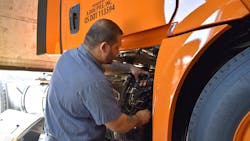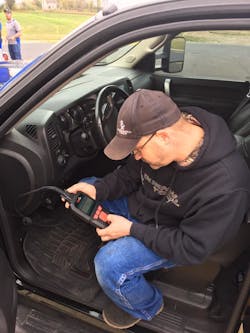Aftertreatment systems are responsible for some of the most common faults found on commercial vehicles, and problems with the systems can result in unplanned downtime if they aren’t addressed. Diagnostic tools, telematics, and preventive maintenance can help, but technicians often face challenges when servicing the systems, which became mandatory for diesel trucks 15 years ago after the Environmental Protection Agency introduced new emissions regulations.
“It is very technical, and technicians jump to conclusions and don’t follow the best diagnostic steps,” said Dan Carrano, VP of fleet maintenance for A. Duie Pyle. “The biggest challenge is finding techs that have an in-depth understanding of exactly how the system functions, allowing them to diagnose the issues properly.”
See also: How KPIs fuel shop efficiency
Daniel Mustafa, director of technical service for TravelCenters of America, said not having a clear understanding of what components in an aftertreatment system do leads to poor diagnostics as well as wasted steps, time, and money.
“The biggest challenges come from the large amount of sensors and the tight tolerances they must operate in, as well as the escalating amount of parts that can be affected before problems are addressed,” said Len Copeland, Detroit product marketing manager, Daimler Truck North America.
Bruno Gattamorta, chief commercial officer for Cojali USA, agreed that the growing complexity of aftertreatment systems has created more issues on the truck: “They get dirty. There are a lot of sensors. They can get clogged and there can be short circuits.”
Getting to the root cause
Finding the true cause, whether that is a clogged diesel particulate filter, wiring problem, or something else, requires a good amount of detective work. Aftertreatment systems can generate multiple fault codes, but technicians need to look beyond those to diagnose the root cause.
“The technician ends up chasing his tail because he is trying to solve the effect, not the cause. You have to know how to find those codes,” said Chris Freeman, director of heavy-duty sales and training for Autel North America. “I think we, as an industry, haven’t done a really good job of training the technicians on how the system works and how to troubleshoot it.”
Instead of looking to resolve the issue, technicians may opt to conceal the problem, calling the manufacturer’s support network to ask how to turn a light off.
“We’ll tell them they have to fix the problem, but they’re just looking to turn off a light and expecting to be able to push a button. There is a lot more to it,” Freeman said. “We try to educate them.”
One major challenge is keeping up with changes in the technology, which has evolved greatly since 2007.
“Some of the machines, depending on the year, will have certain technologies and some won’t,” said Edwin Hopkins, digital solutions business leader at Cummins. “If you’re a fleet owner or have a bunch of machines, you need to have a high level of knowledge of what you have in your equipment.”
Chris Johnson, marketing specialist for Diesel Laptops, said most aftertreatment issues are a result of upstream issues.
“Upstream issues are defined as issues related to the proper function of the engine and related systems. Fueling, cooling, timing, and air handling problems can all present themselves disguised as aftertreatment problems,” he said. “Determining the root cause when an aftertreatment fault code or symptom arises is key to avoiding unnecessary and wasteful repairs.”
See also: Four ways a fleet’s C-suite can improve diagnostics efficiency
One of the biggest challenges for most technicians is understanding the complexities of how the upstream components can interact and cause downstream/aftertreatment components to fail, Johnson added.
The aftertreatment system is a compilation of how well the upstream systems have done their job, and it is not uncommon to have a misdiagnosis as multiple failures can show similar symptoms, noted Duane Tegels, powertrain product marketing manager for Volvo Trucks. “This may result in a technician replacing a damaged component rather than finding the upstream root cause,” he said, adding that a fundamental understanding of the aftertreatment system and surrounding elements is vital to a proper diagnosis.
Excessive engine blow-by, leaking or plugged EGR coolers, faulty AHI modules or 7th injectors, and diesel exhaust fluid (DEF) crystallization can all resonate symptoms in the aftertreatment system, Tegels continued.
Within the system, the diesel particulate filter collects soot; then there is a regeneration process that removes the soot, or the carbon, out of the DPF, but a small amount of ash builds up. “If you don’t clean the ash out, you have excessive back pressure,” Hopkins said, adding that filters must be cleaned or changed regularly.
It is easy for an upstream issue to be misdiagnosed or missed. “Let’s say you have a diesel particulate filter with a face completely plugged. You put in a new filter, and it runs great. A few months later, we have the same condition because we never identified the root cause,” Carrano posed. “It could be a bad injector, bad dosing, or the EGR cooler.”
Technicians have to resist the urge to jump right into a forced regeneration and instead start with a proper diagnostic procedure. “By forcing a regen when it’s not the correct procedure, technicians are wasting time and fuel while placing undue stress on vehicle components,” said Jason Hedman, product manager at Noregon.
Diagnosing the problems
Given the system’s complexity, technicians must use tools to diagnose aftertreatment issues. “Technicians typically can’t look at a fault code and immediately transition into the repair process,” Hedman said. “Because many different factors can cause an issue, the diagnostic and troubleshooting process can be quite extensive.”
There are different levels of technology already in place to diagnose aftertreatment systems.
“Starting from the lower level to the highest level, we have onboard diagnosis,” said Fabio Mazzon, technical manager for Texa, “[such as] warning on the vehicle dashboards, standard code readers, advanced scan tools that offer live data, fault code troubleshooting, bidirectional/resets capability, and remote diagnosis.”
Monitoring faults in real-time can help fleets prepare for when they are able to get their hands on the vehicles. “Driver training and familiarization with the dash lights, what they mean, and how to react is an industry best practice,” Detroit’s Copeland said.
Brian Bressler, director of powertrain aftersales at the Paccar Technical Center, said the best technology is built into the diagnostic capability of the engine’s control module. “EPA and CARB guidelines require the ECU to be programmed with broad and detailed compliance diagnostics, called OBD. The shop needs to possess off-board diagnostic equipment that can read, perform tests, and even analyze the data generated and stored by the ECU,” he said.
Hedman suggests technicians pair a comprehensive electronic diagnostic scan with a visual inspection. For JPRO users, an aftertreatment visual inspection checklist launches when the user opens the aftertreatment diagnostic feature, suggesting the user check for issues such as loose clamps and damaged piping.
Gattamorta said certain codes can’t be deleted without an advanced diagnostics tool. “Most of the tools we sell are because people need to treat the aftertreatment system,” he said.
Telematics devices that send real-time fault-code information provide valuable visibility. “You can see information like elevation, engine load, coolant temperature, and nearly any other relevant vehicle data,” Mustafa said. “This information can be very helpful in resolving ATS issues.”
Cummins has partnered with Elevāt to integrate its Cummins Connected Diagnostics application with the Elevāt Machine Connect IoT platform, to process data and troubleshoot, which Hopkins said can help technicians get to the root cause faster. “We have all of this data, then we’re able to present back to customers through Elevāt on a statistical root cause probability,” he said. “It could be that based on this condition, we think 85% of the time it is the turbo, or NOx sensor, or DEF quality sensor—or it could be that it is a non-Cummins part.”
Copeland said it is important to know the duty cycle, monitor individual vehicles, and follow the maintenance guidelines. Understanding most of this within a Detroit engine can be accomplished through Detroit Connect and Virtual Technician. “Virtual Technician will notify a fleet of faults that occur at different levels of importance. Some codes are information only, some are meant to be addressed at the next scheduled maintenance, and others require immediate attention,” he said.
As a best practice, Hedman recommends that whenever a fleet vehicle is in the shop, planned or unplanned, technicians thoroughly scan the entire vehicle to get ahead of any aftertreatment issues that may not yet be obvious to the driver. He said fleets need to pay close attention to inactive faults on the entire DPF system. “Inactive faults with counts higher than ten are commonly considered active by the OE’s standards and, as a rule, should be treated and repaired as such.”
An example of that is a DEF pump issue. “If the pump is faulting when a passive regen is attempting to start or is in the process of running, it can cause it not to start or can make the regen ineffective,” Hedman said. “Another example is an intermittent DPF sensor pressure fault. The same type of thing can happen here if wiring is damaged or the connectors are faulty. The system won’t let the regen start, or it will stop it in process.”
Freeman noted systems have two NOx sensors, a DEF-level sensor, a DEF quality sensor, and DEF temperature sensors. “Usually, codes will be down to those five sensors,” he said, adding that DEF temperature sensors have been an issue because parts are on national backorder.
Communication between drivers, fleets, and technicians can help technicians diagnose the problem. “When a truck enters the workshop with an aftertreatment issue, the operator should be interviewed to understand the truck’s usage and whether the operator follows best practices,” Bressler suggested. “This should be done before significant diagnostic work is performed.”Preventing issues
General maintenance habits, such as fuel filter and air filter maintenance, help minimize aftertreatment issues. Mustafa recommended fleets establish service intervals for key ATS components such as the fuel doser, DEF doser, and DEF filter replacement. In addition, the DPF should be cleaned on a regular interval rather than relying on the vehicle’s diagnostic systems to identify a plugged or failed DPF.
See also: How shop culture plays a role in recruiting, retaining technicians
Johnson recommended data analysis. “Many aftertreatment/engine-related failures show themselves at fairly defined intervals,” he said. “Looking for patterns of fault codes at certain mileage can give indications of future potential failures.”
The hurdle here for technicians is recognizing the signs of an impending aftertreatment issue, Mustafa said. “Having the knowledge and experience to recognize signs of leaking fuel injectors, coolant issues, leaking DEF and fuel dosers can go a long way to keep aftertreatment system-equipped vehicles operating reliably.”
The DPF portion of the ATS has been around the longest, and fleets have gotten very good at preventive maintenance, diagnosis, and repair of the DPF and the related components, Mustafa said. “Though the SCR system has been around a while, it seems that failures there are on the rise,” he explained.
Bressler said following best practices daily as outlined in the operator’s manual is the best way, and perhaps the only way, to prevent aftertreatment issues.
A. Duie Pyle monitors soot levels during PM inspections and each oil change. “If the soot level reaches a predetermined point, we perform a forced regen,” Carrano said. “It has significantly reduced the amount of parked regens the drivers had to perform during the course of their day.”
As a part of a preventive maintenance plan, technicians should ensure there are no exhaust leaks. “You want to maintain that high temperature so you can maintain that DPF,” said Tim Moore, VP of TMcare Operations for FleetNet America.
Moore added that technicians and drivers should pay attention if they must add coolant, as it could mean the EGR is starting to leak. “That coolant is going somewhere, whether it is on the ground or through the tailpipe,” he explained. “If that goes downstream and through that DPF filter, you can have a problem.”
Installing OEM-approved parts, selecting the correct oil, and/or completing recommended maintenance practices are vital to extending the life of an aftertreatment system, Tegels added.
Properly selecting and spec’ing the correct powertrain can be just as crucial to an emission system as proper maintenance. “Powertrains with manual transmissions and/or higher rear axle ratios typically run higher engine rpms,” Tegels continued. “This is less of a concern when a vehicle’s powertrain is under load. However, the exhaust temperature will naturally drop if the duty cycle requires high engine rpms and low-load conditions such as empty haul backs. Under these conditions, passive regenerations will decrease, requiring additional active regeneration cycles.”
In addition to low-load drive cycles, stop-and-go cycles can be a challenge due to low exhaust temperatures, which limits the system’s ability to perform passive regenerations, requiring a higher frequency of active regens. That is an issue for trucks operating in an urban environment, Carrano said.
“The exhaust aftertreatment system is really a one-size-fits-all system designed for an on-highway application where it is running at a constant speed and temperature. That is where it performs optimally,” Carrano said. “When you put that on a truck operating in a stop-and-go urban environment with a lot of low-load, low-temp operating conditions, it doesn’t get hot enough to turn the soot to ash.”
Educating drivers
Driver behavior is also critical. Moore said one of the biggest issues is drivers not completing a regen when needed. “If you pause it or don’t do it, you get a clogged DPF,” he said.
Mazzon said drivers need to pay more attention to vehicle behavior and dashboard displays. “Most of the time, the drivers ignore the warning messages related to the aftertreatment system until the truck enters into derate mode,” he explained. “At this point, the performances of the vehicle are limited, and it is necessary to drive the truck to the closest shop to have it fixed.”
One of the more common issues is failing to maintain a proper DEF level. If the DEF tank is low on fluid or has improper levels, EPA dictates OEMs restrict that engine. “All of this can be monitored remotely,” Hopkins stated. “In seconds, the fleet will know you will have a power loss within seven hours if you continue running this way.”
See also: Creating career technicians starts in schools, experts say
Hopkins also noted that drivers must use the right fuel. “We’ve found there are some places where they are running higher-sulfur fuel,” he said. “If you’re on-highway, go to any truck stop and there won’t be a problem; but if you’re off-highway, you could end up running some higher-sulfur fuel. You want to make sure you’re running the right fuel for the application.”
Copeland said poor fuel quality is an industry issue, mostly due to a lack of standardization—particularly in the stability of biodiesel fuels.
When improperly stored or contaminated, DEF can cause aftertreatment system issues, specifically in the SCR system, Mustafa warned.
Drivers often ignore the initial level or quality warning because the engine feedback is mild, Bressler explained. “Once the more serious warning is received, it may take several drive cycles after the incident for the warning and engine feedback will abate,” he said. “If prompt action is not taken, even when the driver eventually fills the DEF tank or takes other appropriate action, the warning may persist, putting the driver in the position of either admitting bad behavior or blaming the system.”
Old habits can also create a problem. “There was a time when idling a vehicle only posed a threat to maintaining good fuel mileage. On the modern truck, idling or pulling very light loads can cause the diesel oxidation catalyst to face plug, preventing an effective regen from taking place,” Mustafa noted.
High idle times require an increased frequency of active regens, which can take 45 minutes to complete. Bressler said operators sometimes choose to skip or delay parked regenerations because it detracts from productivity.
Freeman recommended fleets run manual regenerations as often as needed, and he advised drivers to stop and do a regen when the light comes on. “The purpose of doing a regen is to reduce the soot level,” he said. “If the light is on, save yourself time and worry down the road and let the regen go through its process. It is going to save you a lot of heartache and hassle down the road and keep your truck out of the shop.”
This article originally appeared in Fleet Maintenance, one of FleetOwner's sister sites.






